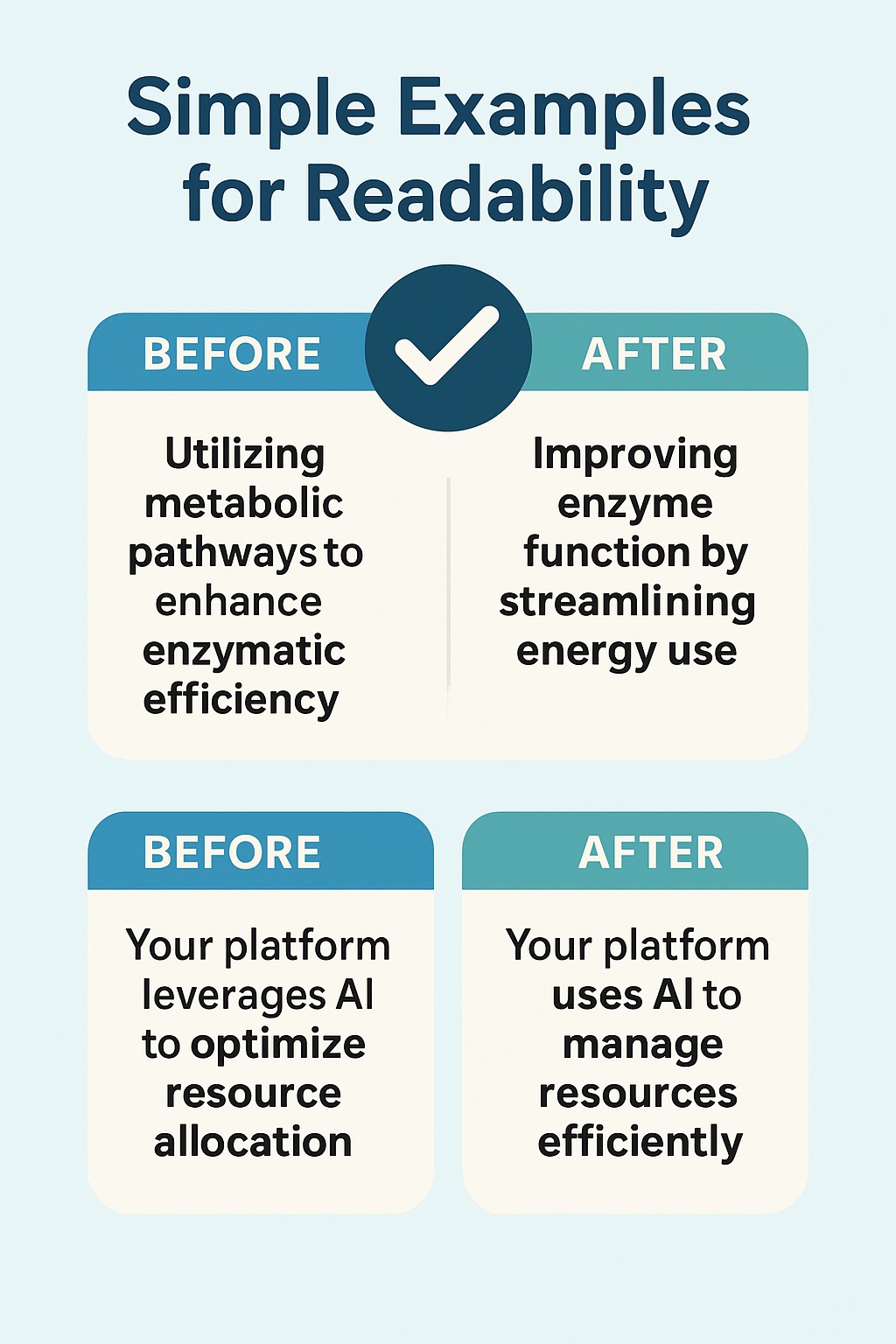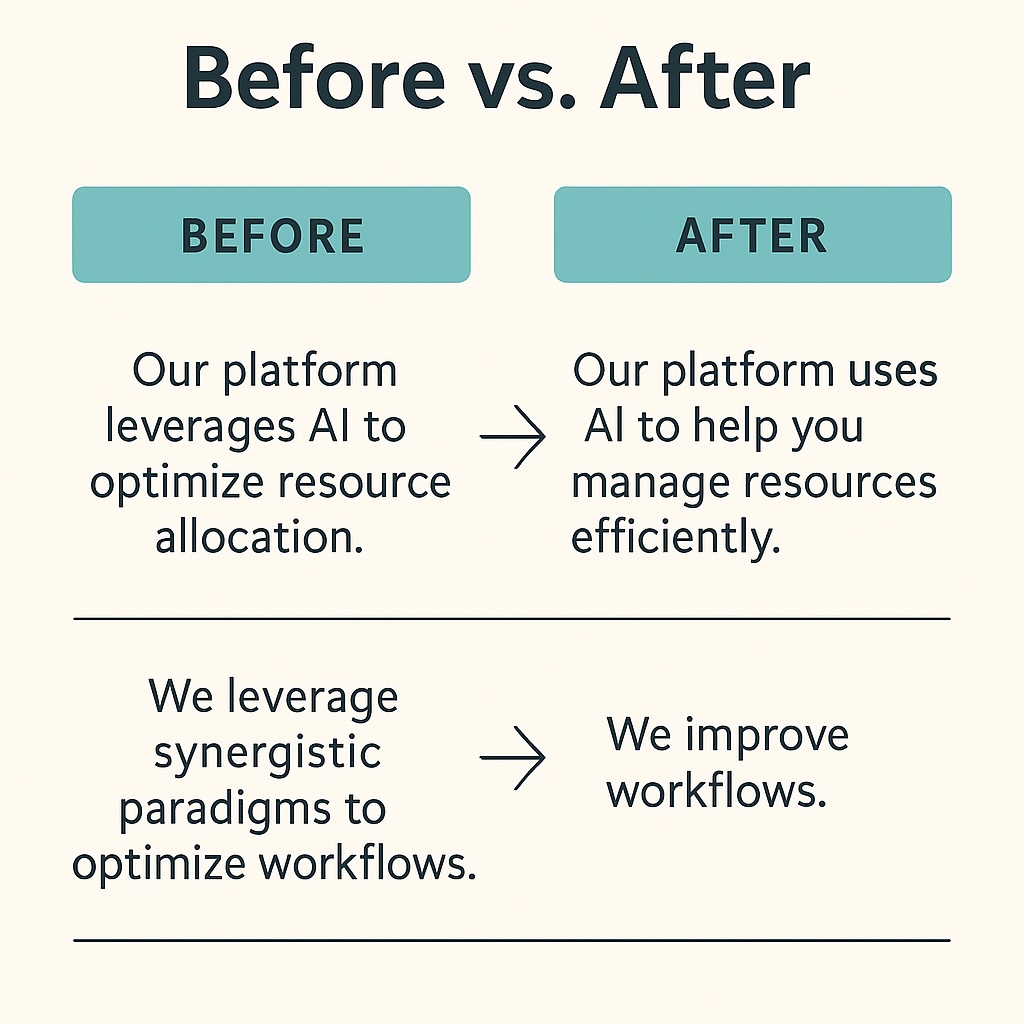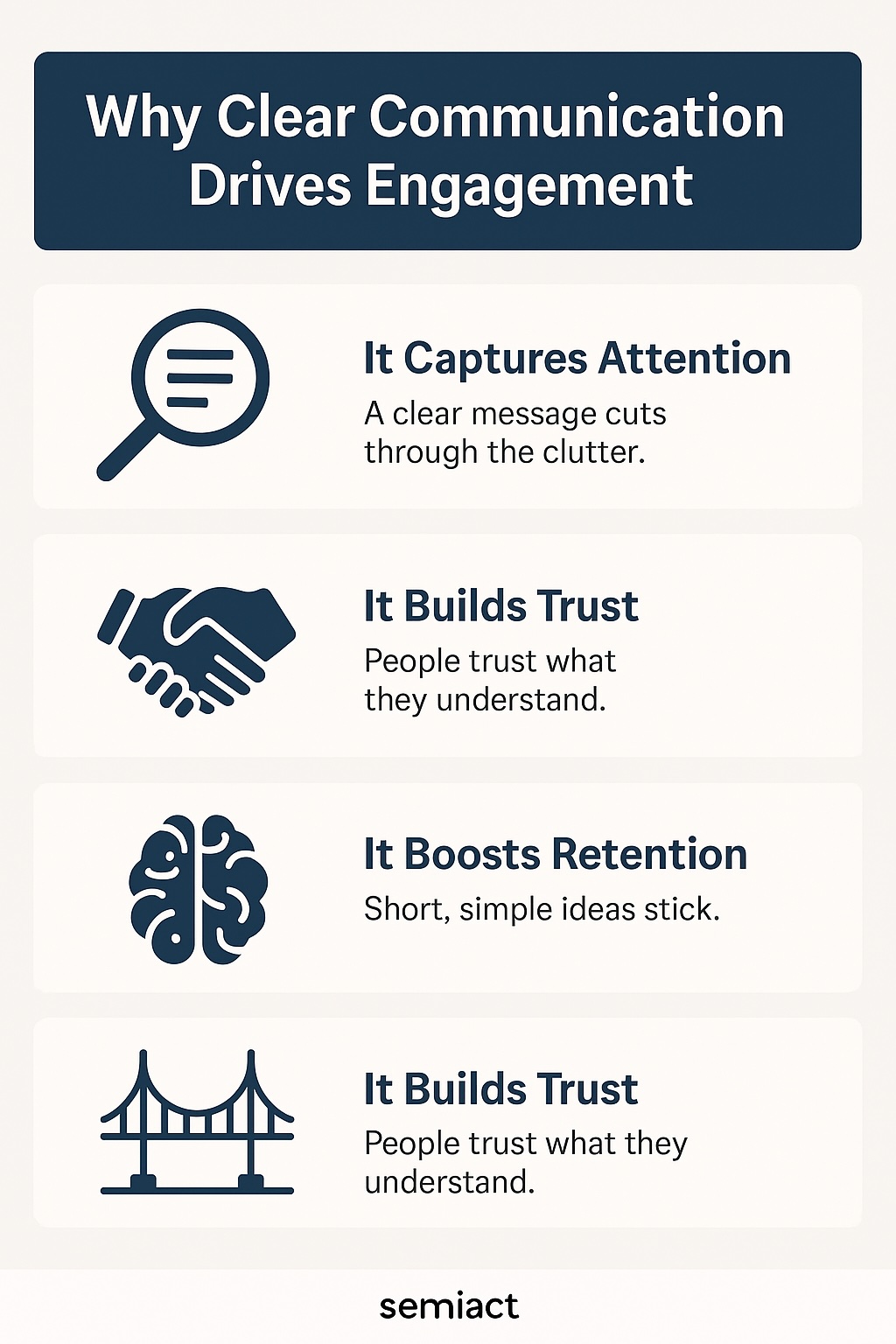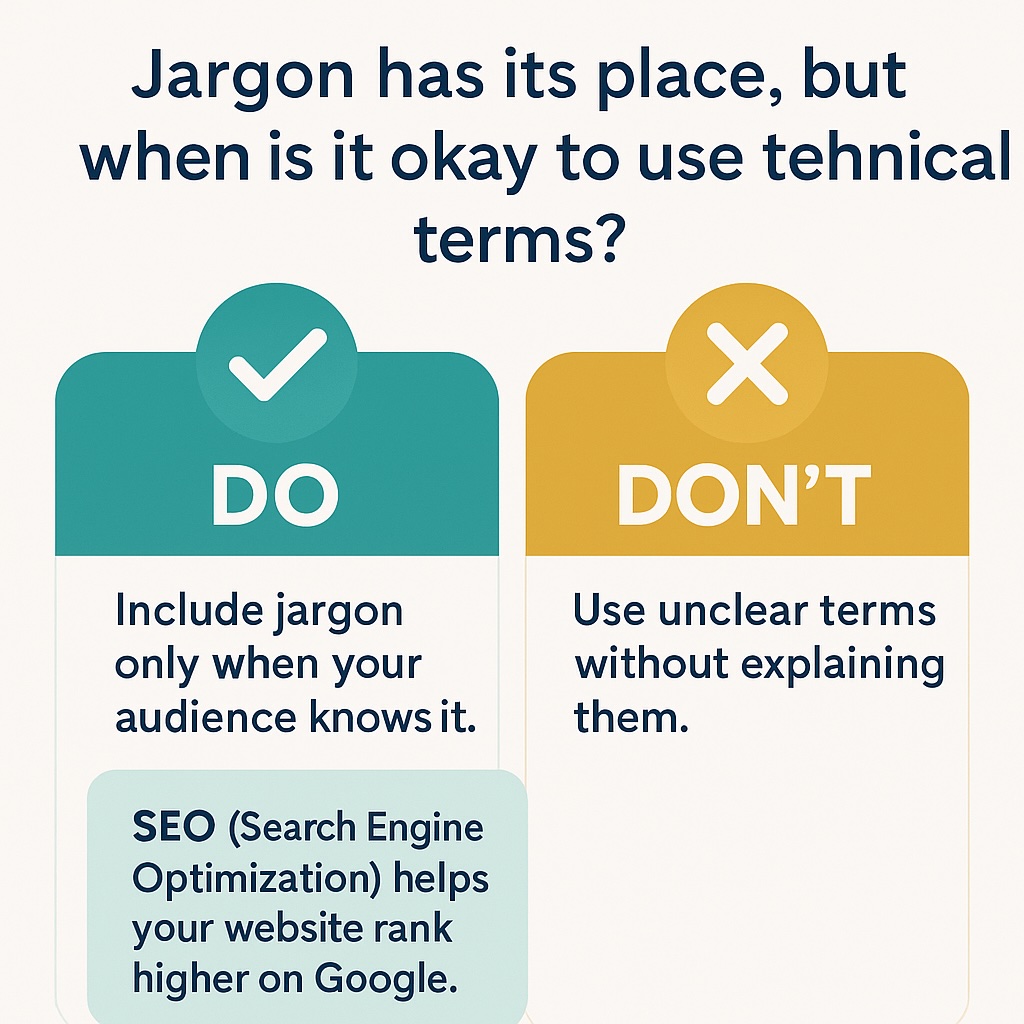Turn complex ideas into clear, engaging messages your audience will actually care about.
For years, I worked in corporate America, where jargon and complex language were the norm. Speaking in acronyms and business buzzwords became second nature. So when I started writing for myself, I struggled to shift into a more conversational tone.
Everything I wrote was technically accurate, but it didn’t resonate. My message didn’t reach the people I wanted to reach, and that was frustrating.
So I did what I do best—I dug in. I studied what makes writing connect. And the answer was surprisingly simple: writing should be easy to understand. It shouldn’t make your reader stop and decode your message—it should just make sense.
I started using tools like the Hemingway App to simplify my sentences and sharpen my message. And the more I embraced clarity, the more powerful my writing became.
Ever spend hours crafting what felt like the perfect message, only to watch it fall flat? Your ideas were solid—maybe even brilliant. But your audience? Confused. Disengaged. Gone.
The issue isn’t your thinking—it’s your delivery.
Dense, jargon-filled writing acts like a wall. It keeps people out. Even the smartest ideas lose their edge when wrapped in complexity.
Here’s the upside: simplified writing doesn’t just make your message easier to read—it makes it impossible to ignore. When your words are clear, they cut through the noise. They spark curiosity. They drive action.
In this guide, you’ll learn how to turn tangled sentences into sharp, strategic communication. Simplify your writing, and you’ll do more than get noticed—you’ll build trust, create a connection, and make your message stick.
Let’s kick off with the key takeaways that will set you up for success.
Key Takeaways
Simplified writing does more than make your message easier to read—it amplifies your impact and deepens audience connection. Here’s what you’ll gain from this guide:
Complex, technical language creates barriers. Simple, straightforward language breaks them down.
Transparent, easy-to-follow messaging inspires confidence and builds long-term credibility.
Relatable stories make even the most complex ideas memorable and meaningful.
When your writing aligns with your audience’s needs and preferences, it motivates action.
These principles will transform your communication, turning smart ideas into messages that resonate, inspire, and drive results.
Why Clear Communication Is Essential for Engagement
In a world overloaded with distractions, clear communication isn’t optional—it’s essential.
Every email, blog post, or presentation competes for attention in an environment where attention spans are short and patience is even shorter. If your message is hard to follow, your audience won’t stick around—they’ll bounce.
But clarity isn’t just about grabbing attention—it builds trust.
Imagine receiving two emails about the same product:
Which one feels more approachable? Easy: the second. It’s simple, human, and direct—all the traits that make communication effective.
Why Clarity Matters
A clear message cuts through the clutter and makes people stop, read, and engage.
People trust what they understand. Clarity removes confusion and creates confidence.
Short, simple ideas stick. Clarity helps your message stay top of mind, whether it’s a smart headline or a clean call to action.
A Quick Comparison
Think of your message as a bridge. Load it with jargon and complexity, and your audience won’t risk crossing it. But build it with strong, simple, direct language? They’ll walk across.
Now that we’ve nailed the power of clarity, let’s shift to the next essential ingredient: understanding who you’re writing for—and what actually matters to them.
The Pitfalls of Jargon
Jargon might sound impressive, but more often, it’s the quickest way to lose your audience.
While technical terms may work inside niche circles, they confuse and alienate the broader group you’re trying to reach. Think of jargon as a locked door: insiders might feel “in the know,” but everyone else gets shut out.
And let’s be honest—if your readers have to work to understand your message, most won’t. They’ll just move on.
Why Jargon Fails
Say this: “We leverage synergistic paradigms to optimize workflows.”
Now explain it. Exactly.
Unfamiliar terms make readers feel excluded, overwhelmed, or frustrated—none of which build trust.
The more complex your language, the more likely your main point gets buried. Great ideas shouldn’t need translating.
How to Avoid Jargon
Replace industry-speak with real words.
Instead of: “Optimize deliverables.”
Say: “Improve results.”
If a technical term is essential, explain it briefly.
Example: “SEO (Search Engine Optimization) helps your site show up in search results.”
Ask: “Would someone outside my field get this instantly?”
If the answer’s no, simplify.
Example in Action
When your message is clear, your ideas don’t just land—they connect.
Now that you know why clarity beats jargon, let’s look at how simplified writing can elevate every part of your communication.
The Benefits of Simplicity
In a world drowning in information, simplicity is your competitive edge. Clear, direct writing grabs attention and creates a lasting impact.
But let’s be clear—simplicity isn’t about dumbing things down. It’s about refining your message so it’s easy to understand, easy to remember, and easy to act on.
Think of it as building a shortcut straight to your audience’s brain.
How to Avoid Jargon
Imagine explaining an idea to a friend. You’d skip the buzzwords and speak in plain language. That’s what simplicity does—it removes the friction between your message and their understanding.
Clarity feels honest. When people don’t have to decode your words, they’re more likely to believe and follow what you’re saying.
Simplicity makes your message accessible to everyone, from seasoned pros to curious newcomers.
Studies show simple messages are easier to recall.
Think of: “Just Do It.” Short. Bold. Unforgettable.
Real-World Example
Real-World Example
Take Apple. Their messaging leads with benefits, not specs.
One makes you think, and the other makes you want. That clarity has helped build one of the most loyal customer bases on the planet.
Quick Tips to Keep It Simple
Don’t overload. Let each point breathe.
Aim for 15–20 words. If it feels long, break it.
Say “start” instead of “commence.” Say “use,” not “utilize.”
If it doesn’t add value, cut it. Clean writing equals clear thinking.
Let’s dive into the how—the tactical writing techniques that will help you simplify your message and connect with clarity.
Techniques for Simplifying Your Writing
Simplicity doesn’t happen by accident—it’s intentional. It takes strategy, clarity, and the willingness to cut what doesn’t serve your message.
The good news? Simplifying your writing doesn’t water it down—it sharpens it. It helps your ideas hit harder and stick longer.
Here’s how to make simplicity your default:
Use Active Voice
Active voice is clear and direct, making your writing more engaging. Instead of saying, “The team completed the report,” say, “The team completed the report.”
Why It Works: It eliminates unnecessary words and puts the focus on action.
Break Down Long Sentences
Long sentences can overwhelm readers and obscure your message. Break them into smaller, digestible chunks.
Before: “Our system, developed over several years, is designed to improve productivity, reduce costs, and streamline operations.”
After: “Our system improves productivity. It reduces costs and streamlines operations.”
Replace Jargon with Everyday Words
Jargon may sound impressive, but it alienates your audience. Use simple, relatable language instead.
Before: “Our platform leverages AI to optimize resource allocation.”
After: “Our platform uses AI to help you manage resources efficiently.”
Focus on One Idea Per Sentence
Cramming multiple ideas into one sentence can confuse your audience. Keep it simple by addressing one idea at a time.
Before: “Our product improves efficiency, reduces costs, and offers customization for different industries.”
After: “Our product improves efficiency. It reduces costs. It’s customizable for different industries.”
Edit Ruthlessly
Editing is where clarity is born. Look for redundant words, vague phrases, or anything that doesn’t add value, and remove it.
Before: “In order to maximize your experience, we suggest you explore all of our available features.”
After: “Maximize your experience by exploring all our features.”
Real-World Examples of Simplified Writing
Simplicity isn’t just a principle—it’s a strategy used by world-class brands to connect, convert, and build loyalty. Here are five standout examples of how clear, straightforward messaging drives results:
Apple: Tech That Speaks Human
Apple is a masterclass in translating complexity into clarity. Instead of drowning users in specs, they highlight what matters: the benefit.
Why it works: Apple focuses on speed—the outcome users care about—making the message resonate far beyond tech enthusiasts.
Southwest Airlines: Clarity That Builds Trust
Southwest’s messaging is clear, bold, and customer-first.
Message: “Bags fly free. No change fees. Low fares. Nothing to hide.”
Why it works: Transparent language sets expectations, reinforces reliability, and builds instant trust.
TED Talks: Big Ideas, Simple Delivery
Great TED speakers don’t use jargon—they use analogies, storytelling, and relatable metaphors.
Example: “Your brain works like a GPS, mapping out decisions before you even realize it.”
Why it works: Instead of dense technical language, they deliver clarity through familiarity, making abstract ideas stick.
Slack: Onboarding That Doesn’t Suck
Slack makes getting started effortless with direct, step-by-step language.
Why it works: Clear directions reduce friction and increase adoption. No guessing, no frustration.
In-N-Out Burger: Minimalism That Sticks
In-N-Out’s messaging mirrors its famously simple menu.
Message: “Quality you can taste.”
Why it works: Four words. One promise. Instant recall. That’s clarity with staying power.
Key Takeaways
Inspired by these examples? Let’s look at the best tools you can use to simplify and strengthen your own writing—fast.
Measuring Audience Engagement
Simplifying your writing helps build a connection, but how do you know it’s working? The answer lies in tracking engagement.
Engagement goes beyond clicks or views. It’s about meaningful interaction. Are people sticking around? Sharing your content? Taking action? These signals show whether your words resonate or fall flat.
Why Audience Engagement Matters
High engagement shows your audience values what you’re saying—and that strengthens credibility.
Engaged readers are more likely to subscribe, share, download, or buy.
Engagement data reveals what’s landing, what’s lagging, and where to improve next.
Key Metrics to Track
Longer times suggest your content is relevant, easy to follow, and engaging.
A high bounce rate means people are leaving too soon, possibly due to confusion or lack of connection.
Tracks how often readers engage with your CTAs. Higher CTR = more persuasive writing.
These are signs your content hit a nerve—emotionally or intellectually.
This is the ultimate signal: did your content lead to a sign-up, download, or purchase?
Tools for Tracking Engagement
How to Use Engagement Data to Improve
Now that you’re tracking engagement, it’s time to go one level deeper—addressing the questions your audience is already asking.
Let’s explore the most frequently asked questions about simplifying your writing.
Measuring Audience Engagement
Simplifying your writing can feel tricky, especially when you’re dealing with complex ideas or technical topics. Here are answers to common questions about creating clear, engaging content that resonates with any audience.
How Can I Simplify Complex Ideas Without Losing Depth?
Simplification isn’t about dumbing down—it’s about making your ideas easier to grasp.
✔️ Try this: Use analogies, relatable examples, or step-by-step explanations.
Why it works: Analogies make abstract concepts tangible and memorable.
Is Simplified Writing the Same as Dumbing It Down?
Nope. Simplifying your writing respects your reader’s time and brainpower. You’re making it easy to understand, not stripping away the value.
Pro Tip: Think of it as distilling, not diluting. Clarity makes you sound smarter, not simpler.
When Is Jargon Appropriate?
Use it sparingly—and only when your audience knows it. If a term is necessary, define it.
Example: “SEO (Search Engine Optimization) helps your website rank higher on Google.”
Why it works: Clear context keeps your audience with you, not Googling definitions.
How Does Visual Design Help Simplify Writing?
Good writing paired with good design is unstoppable. Use bullet points, headers, spacing, and visuals to guide the reader’s eye and reinforce clarity.
Pro Tip: A clean layout, clear hierarchy, and visual aids (like infographics or charts) make dense information feel digestible.
5. Can Simplified Writing Work in Technical or Academic Settings?
Absolutely. Clarity enhances credibility in academic and technical work—it doesn’t undermine it.
Why it works: The message is still precise, but now it’s also readable.
Next, simplifying your writing isn’t about changing your message. It’s about making sure it connects. Let’s wrap up with one final metaphor to bring it all home and make it stick.
Conclusion: Simplicity Is Your Superpower
Think of your message as a lighthouse cutting through the fog. If that light is dimmed by jargon or complexity, your audience won’t find their way—they’ll drift.
Clarity isn’t just a nice-to-have. It’s a beacon. It builds trust, inspires action, and makes your message impossible to ignore.
Simplifying your writing doesn’t weaken your message—it amplifies it. When your words are easy to understand, they create impact that lasts.
By embracing simplicity, you:
The best communicators don’t use big words to sound smart. They use clear words to create big connections.
Whether you’re writing a headline, a blog, or a pitch deck, your job is the same: resonate with your audience.
Final Thought
In a world flooded with noise, clarity is your edge. Keep your message focused, your language simple, and your audience at the center of every word you write.
Call to Action
Ready to transform the way you communicate?
Start simplifying today. Apply the techniques, track what resonates, and watch your audience grow.




